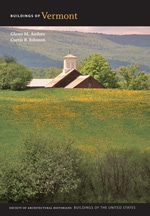
This severely massed and crisply restored house is notable for Federal detailing unique to its region and among the most elaborate in Vermont. The two-and-a-half-story Georgian-plan house sits in the center of the one-hundred-and-sixty-acre farmstead settled by David Hibbard, a noted lawyer, legislator, and side judge in early-nineteenth-century Essex County. Tradition asserts that, while adding the front block of the building to his earlier kitchen wing, Hibbard employed an itinerant craftsman, and supposed escaped convict, who lived with him for two years carving the house's classically inspired trim. That the house had grand ambitions is evident in the granite facings on its fieldstone foundations, but especially in the woodwork. The horizontal and raking cornices include block and cone-shaped dentils, drill work, mutule blocks, and fine cyma recta moldings. The imposing frontispiece frames a transomed door and sidelights with vine-carved and tapered fluted pilasters, an entablature with scallops, drill work, a Doric frieze of triglyphs and metopes, and a mutule-supported projecting cornice. As in many rural Vermont buildings, the house's cladding changed over the years and it now has a galvanized metal roof. However, the massing is unaltered and its remarkable trim is weathered but largely intact. In the 1990s the house was renewed with new clapboards cut to the original gauge and the careful reproduction of missing moldings.

